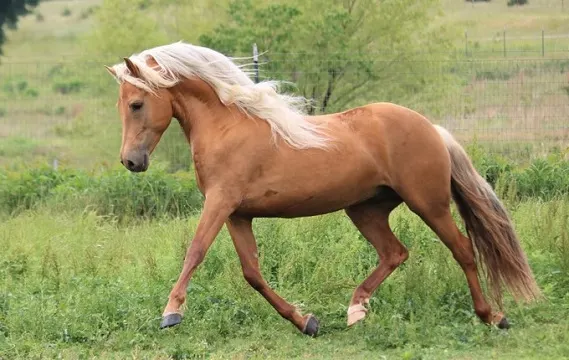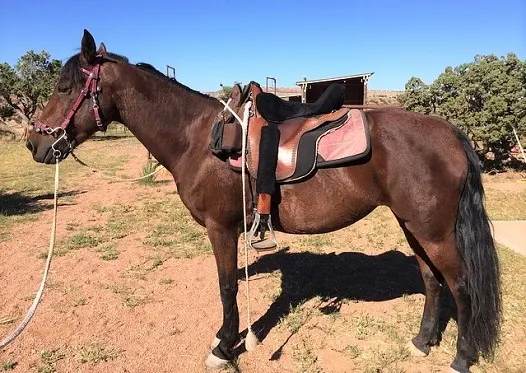The Morgan horse is one of the first breeds developed in America. Known as “the horse that chooses you,” this beautiful breed is eager to please, making them great companions.
Morgan horses have an elegant yet sturdy build, with a proud carriage and beautifully refined head. They are a versatile breed, excelling in riding and driving disciplines both in and out of the show ring. Morgans are friendly, intelligent horses that are wonderful for the entire family.
Morgan Horse BreedStats Height:14.1 – 15.2 hands Weight:800 to 1,000 pounds Colors:bay, black, & chestnut Body Type:Compact, muscular, expressive head, large eyes, arched neck. Temperament:Gentle, friendly, animated Life Expectancy:25 – 30 years
Let’s dive into the Morgan’s history, characteristics, facts, and other common FAQs.
History & Origin of the Morgan Horse Breed
The Morgan breed got its start in Vermont during the late 1700s. It all began when a school teacher by the name of Justin Morgan was given a small bay colt named Figure. Morgan quickly realized that this little foal was something special.
Figure stood at just 14 hands tall and had an intelligent head with large expressive eyes and a well-muscled body. Despite his small stature, he was able to out-trot, out-run, and out-pull horses all throughout the New England area. He soon became a local celebrity and people were eager to breed their mares to Justin Morgan’s horse.
Figure passed on his good looks, athleticism, and friendly personality to his offspring. He became a living legend and went on to become the foundation stallion of the Morgan breed. Though no one knows for sure what Figure’s pedigree was, many believe it traces back to Arabian, Thoroughbred, Welsh cob, and even Friesian bloodlines.
Figure later renamed Justin Morgan after his owner. After all the foals he went on to sire, there were three that stood out. Sherman, Woodbury and Bulrush all went on to be influential stallions in the Morgan breed, carrying on their father’s legacy.
Morgans quickly grew in popularity across the United States. During the Civil War, they were popular warhorses for soldiers, as they were strong, athletic, eager to please, and easy keepers. They became sought after as show, pleasure, and work horses for both riding and driving. The Morgan also went on to influence other American breeds including the Standardbred, Quarter Horse, Tennessee Walking Horse, and American Saddlebred.
In 1894, the first volume of the American Morgan Horse Register was published. Then as the breed grew, the Morgan Horse Club (now known as the American Morgan Horse Association) was established in 1909. Today, Morgans are in all 50 states and all across the world, including Canada, England, Italy, France, Germany, Australia, New Zealand, Mexico, and South America.
What is the Height & Weight of a Morgan Horse?
Morgan horses are on average 14.1 to 15.2 hands tall and weigh between 800 to 1,000 pounds. Some Morgans may vary in height, being under 14.1 or over 15.2 hands tall.
As a type of light horse, Morgans are a wonderful size for both children and adult riders. They are also an ideal size for driving, with their agility and strength-giving them the capability to pull heavy loads.
What Color is a Morgan Horse?
Morgan horses come in a variety of different colors including bay, black, chestnut, gray, palomino, buckskin, and dun. The most common colors you will see in the breed are bay, black, and chestnut.
There are some Morgan horse enthusiasts that breed specifically for colorful Morgans. This has led to Morgans in rare colors such as grulla, cremello, perlino, smoky cream, flaxen, sabino and splash. Though these colors are not common within the breed, they are growing in popularity.

Lisa Kolbenschlag / Shutterstock.com Morgan Horse Characteristics & Temperament
Morgan horses have gentle, friendly temperaments. They are affectionate horses, full of personality, and make great horses for people of all ages and experience levels. Morgans are calm yet animated, and are highly trainable and reliable, making them trustworthy horses.
With a stylish way of moving, Morgans have refined heads, intelligent eyes and well-arched necks. They have compact bodies, with good muscling all throughout. Morgan horses have athletic builds, allowing them to excel at whatever they do. This special breed is sure-footed and hardy.
Morgan Horse Breeding and Uses
The Morgan breed has changed little since it was first established. Today, some people breed for taller, leaner horses that stand 16+ hands tall.
In the Morgan breed, there are four main bloodlines: Brunk, Government, Lippitt and Western Working “families.” The Brunk line traces back to Joseph Brunk’s breeding program in Illinois and the horses are known for their athleticism and soundness. Of the four bloodline families, the Government is the largest, as it traces back to the Morgans bred at the US Morgan Horse Farm from 1905 and 1951.
The Lippitt bloodline is said to be the purest of the four. The line focuses on horses that are descendants of Ethan Allen II, with no outcrosses to other breeds during the 20th or 21st centuries. Morgans in the Western Working family have no common breeder or ancestor, but are bred to be ranch horses and work cattle.
Today, the Morgan horses have many uses. Though they are most known as show and pleasure horses, they also excel in trailing riding, ranch work and even therapeutic riding programs. They are a versatile breed, as Morgans compete in saddle seat, hunter pleasure, jumping, western pleasure, reining, dressage, eventing, endurance and driving disciplines.
Morgan Breed Standard:
According to the American Morgan Horse Association, a Morgan horse should have:
An expressive head with a broad forehead, large prominent eyes and a straight or slightly dished short face. The ears should be short yet shapely, set rather wide apart and be carried alertly.A throatlatch that is slightly deeper than other breeds. It should be refined, allowing the horse to have proper flexion at the poll.A neck that comes out on top of a well-angulated shoulder, having depth from top of withers to point of shoulder. It should be slightly arched, blending with the withers and back. Stallions should exhibit more crest than the mare or gelding.A body that is compact, with a short back and straight legs with overall refinement. The tail should be high and gracefully carried.Distinctive attributes such as animation, stamina, alertness, adaptability, attitude and tractability. Can You Ride a Morgan Horse?
Morgan horses are an ideal horse for beginner riders, but also exciting for more advanced riders. Their athleticism, animation, and adaptability make them great for English and western riding disciplines.
Children and adults alike both enjoy riding Morgan horses. Their flashy way of moving makes them a blast in the show ring, but their sensible attitudes also make them a suitable horse breed for trail riding.
How Much Does a Morgan Horse Cost?
On average, a Morgan horse will cost between $5,000 to $30,000. However, some top show horses and stallions cost upwards of $50,000. Price can vary widely depending on many factors such as age, bloodlines, training, and gender.
If you are looking for a Morgan horse for trail or pleasure, you can find horses for $7,000 and under. Show horses will often cost $10,000 and upwards, with most top show Morgans going for anywhere between $15,000-$60,000, or even more.

Famous Morgan Horses
Throughout history, there have been some notable Morgan horses. Though Figure is the most famous Morgan in the breed, others have also had their time in the spotlight.
During the Civil War, General Philip Sheridan rode a Morgan named Reinzi. Sheridan would rally his union troops while aboard his trusty mount. His preserved remains are now on display at the Smithsonian museum. Another famous warhorse, Comanche, a horse of Morgan heritage, was the famed ‘lone survivor’ Battle of the Little BigHorn.
If you have ever seen the trotting horse wind vane, it is modeled after a Morgan named Ethan Allen. Ethan Allen was famous for his trotting ability, as he was a world champion trotter and the fastest stallion of the day.
7 Facts About the Morgan Horse
Morgan horses have drawn the attention of people across the world for their stunning looks and friendly personalities. This has led to Morgans being prominent in book series and even on the big screen.
In 1945, Marguerite Henry wrote the beloved book, Justin Morgan Had a Horse. This classic novel tells the tale of Figure’s legendary life and the start of the Morgan breed.Later in 1972, Disney adapted Henry’s book to make the movie Justin Morgan Had a Horse.They are the state animal of both Vermont and Massachusetts.The University of Vermont has its own Morgan horse farm.Ellen Feld wrote a series of children’s books all about Morgan Horses.They are America’s first official breed of horse (the first breed was the now-extinct Narragansett Pacer).Every registered Morgan traces back to Figure. Frequently Asked Questions How Long Do Morgan Horses Live For?
Morgan horses on average live for 25-30 years old. It is not unheard for Morgans to live well into their 30s as well. They have a longer lifespan than the average horse. This in part is due to the fact that they have remarkably few medical conditions present within the breed.
Are Morgans Easy Keepers?
Morgans are often easy keepers, as they typically need a minimum of grain and grass when compared to most other breeds. Their strong builds and inherently healthy natures allow them to live long lives.
The fact that Morgans are easy keepers made them popular mounts during the Civil War. They could survive on less food than other horses and were healthy, sturdy, and reliable. Today, however, owners must be wary not to overfeed their Morgans, as being easy keepers can mean they are prone to becoming overweight.
When Was The Morgan Horse Figure Born?
Figure was born in 1789. He went on to live to 32 years old, which is quite old for a horse at that time. After spending his life working in fields and on the roads of Vermont, Figure died in 1821 from an untreated kick from another horse.
How Many Morgan Horses Are There?
As of 2015, there are approximately 90,000 registered Morgan horses in America. There are around 175,000 Morgan horses worldwide.
What is the Difference Between a Morgan and Quarter Horse?
Morgan horses usually have a smaller proportioned body than the Quarter, being shorter and leaner. Additionally, a Morgan horse is often gaited, whereas a quarter horse isn’t.
Are Morgan Horses Gaited?
Though the majority of Morgans are not gaited, there are some horses within the breed that are naturally gaited. Morgan horses that are gaited will perform a walk, trot, canter, gallop and do ambling gaits.
These ambling gaits include the rack, pace, and fox-trot. There are no specific families or bloodlines that are predominant in producing Morgans that can gait.
Source: horseyhooves.com





